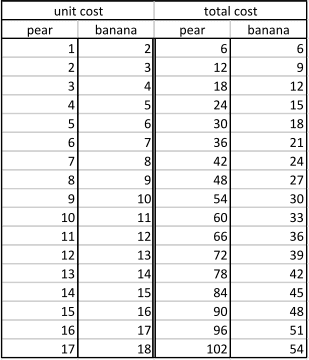When Simon was a youngster, many years ago, he was sent out to buy some fruit, and he came back with three bananas and a half-dozen pears. When his mother asked what he had paid, however, the clever fellow wasn't going answer so easily.
"The bananas cost one cent each more than a pear did," he said, "and on my way home I realized that what I paid for the pears was the same as I paid for the bananas, but reversed."
His mother couldn't get anywhere with that information and asked, "What do you mean by 'reversed'?"
"OK, I paid less than a dollar for each lot, and the amounts for the two lots were the same figures, but for one lot they were the other way around."
We will leave Simon's mother to wrestle with this information, while you wrestle with it yourself. How much did Simon pay altogether?
Solution
A direct approach: make a chart and try successive possibilities.
In the spreadsheet below, the first column runs through the possible unit pear prices, the second column are the unit banana prices (exactly one cent more than the pear prices). The third and fourth columns give the resulting total costs for 3 pears and 6 bananas, respectively. We are looking for a row where the total costs have reverse digits.
An answer appears in the seventh row (42 and 24) but to be cautious we run the sheet down until the costs exceed a dollar. This happens at row 17, with no more successes. So, going back to row seven, the total that Simon spent was 66 cents.
